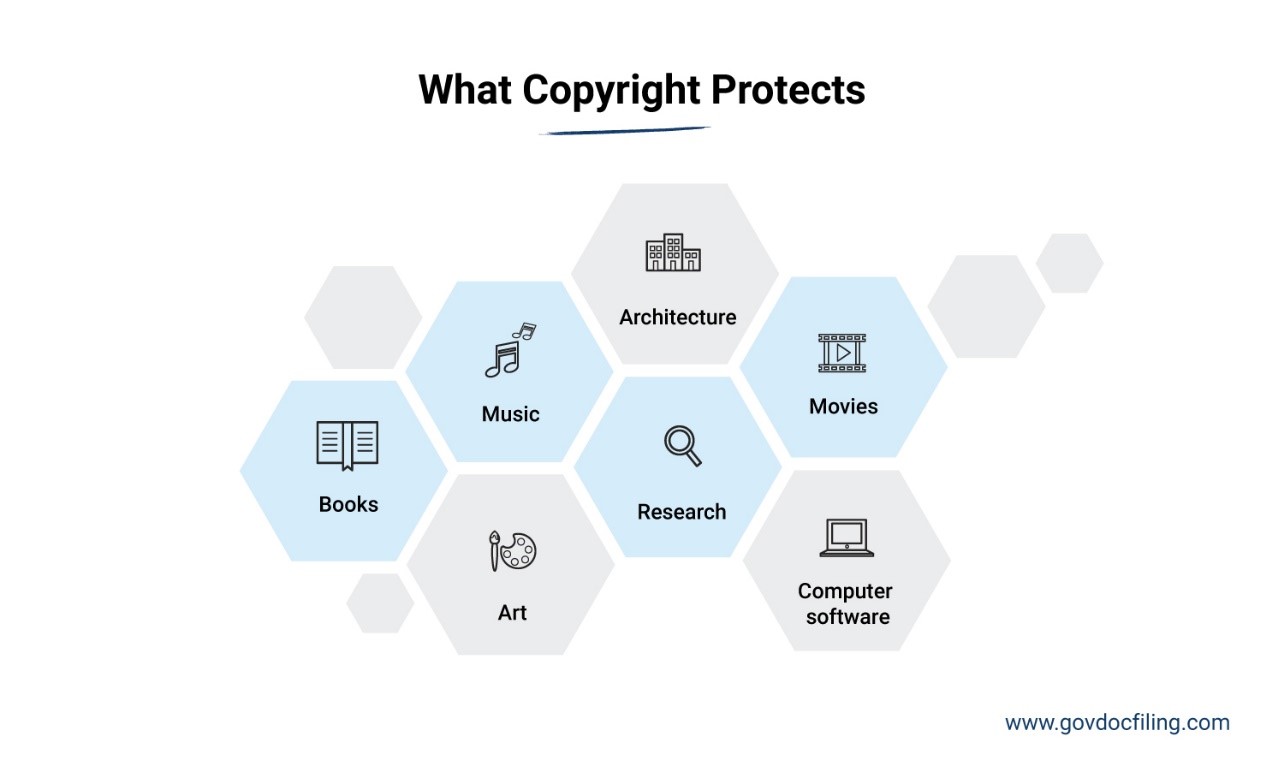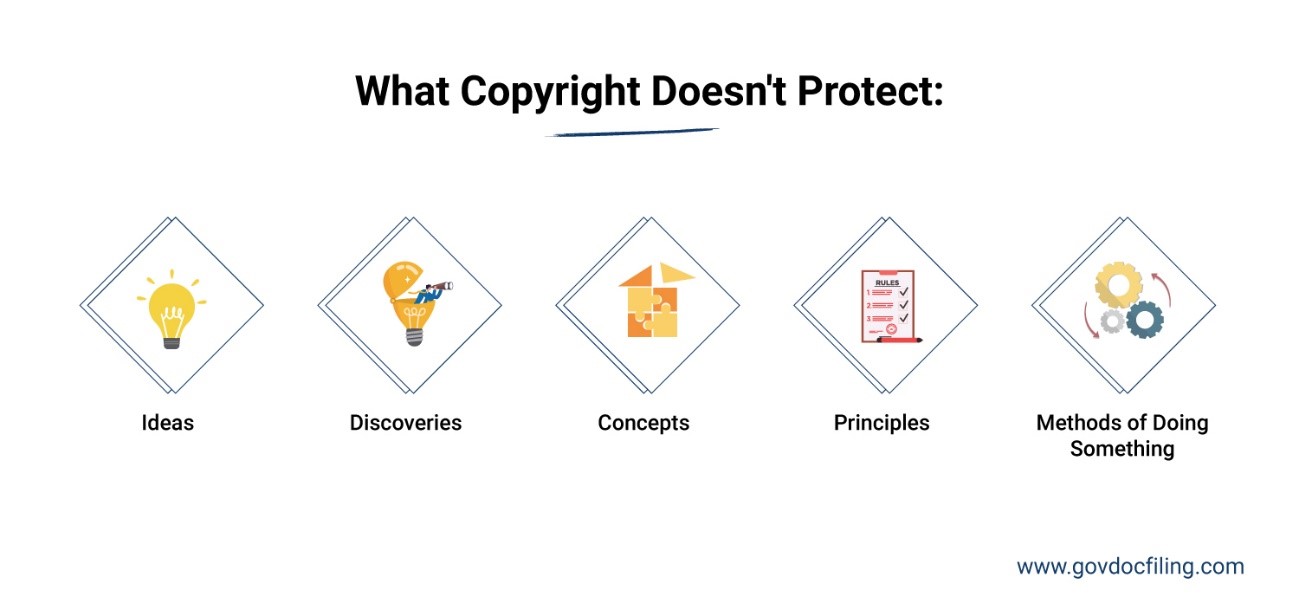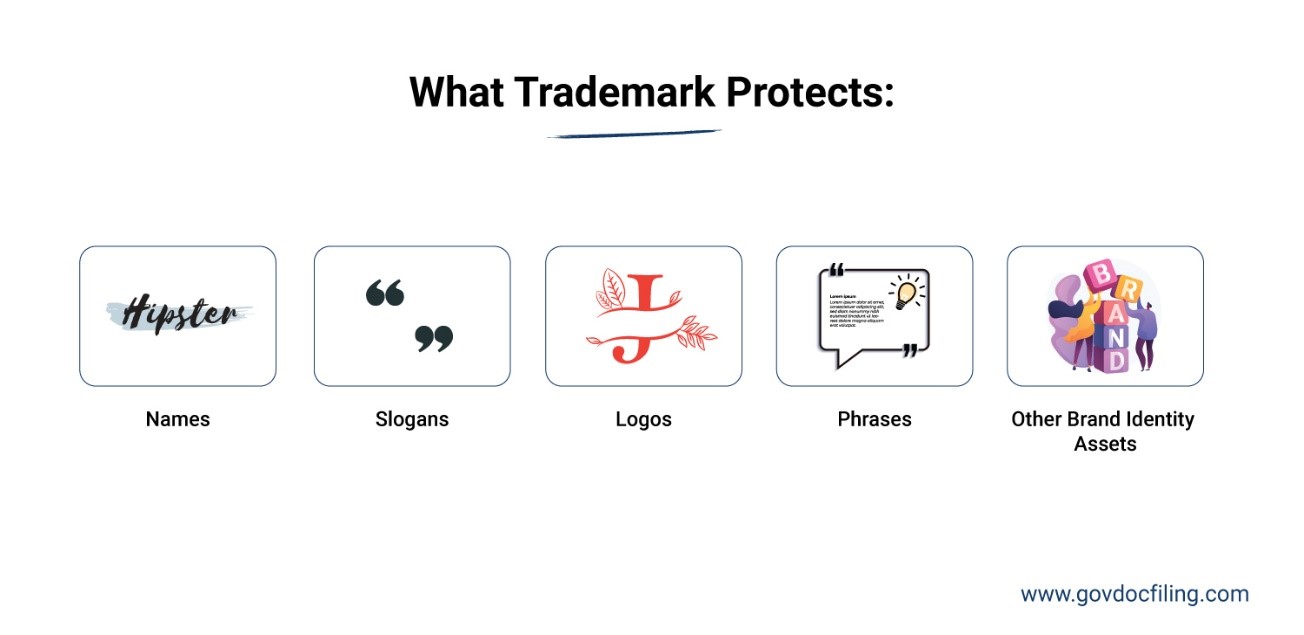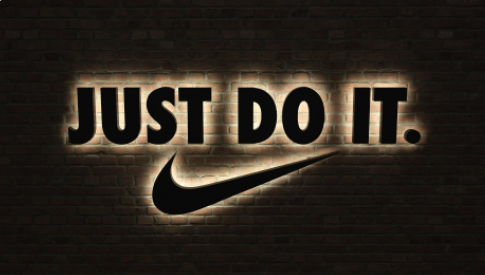Trademark and copyright both help protect your intellectual property. It can be confusing to figure out the difference between the two and when you should use each.
This article will help you understand the difference between copyright and trademark.
Trademarks and copyrights are intangible assets that bring your company revenue and help you make money directly or indirectly.
As a business owner, you need them to protect your items, such as your business’ name and logo, products’ names, designs, and tagline.
A trademark or copyright protection prevents other people from using your creativity and/or brand to make money for themselves.
How do you know which one is right for your business?
Let’s take a closer look at what copyrights and trademarks protect, their key characteristics, differences between the two, and how to obtain both.
Copyright vs. Trademark: What’s the Difference Between the Two?
The key difference between copyright and trademark is the types of intellectual property each protects.
Here’s an in-depth look at the chanrateristics of each one of them and the difference between the two.
What is a Copyright?
Copyright is an intellectual property protection law, which protects original literary and artistic works. These include items such as:
- Books, e.g. novels and poetry
- Musical works, e.g. songs, videos
- Architecture
- Intellectual works, e.g. research
- Other forms of video and audio material
- Movies
- Art e.g. painting, sculpture, drawing, and photography
- Computer software
Besides being original, your work needs to be creative and unique. This is not a requirement for trademarks, which makes it a major difference between copyrights and trademarks.
The work must be fixed in a tangible medium to be copyright protected. This means existing in a fixed form, such as a film, a system, a print form, or a recording.
For this reason, copyrights do not protect items such as:
- Ideas
- Discoveries
- Concepts
- Principles
- Methods of doing something
Other items that copyright protection does not cover include brand names, titles, slogans, and short phrases.
These are items protected by a trademark. It’s one fundamental difference between copyright and trademark.
However, you can copyright an artistic logo if you can prove that it contains sufficient authorship.
Work that is in the public domain cannot be copyrighted, which is another difference between copyrights and trademarks.
There are varying interpretations of what public domain means. In the US, it means any work written before 1923.
Work that is common property, such as calendars, cannot be copyrighted as well.
It brings us to another common difference between the two.
You can trademark common word phrases like Apple Inc. did with the word “Apple”. You only need to prove that the name has a secondary meaning that’s dinctict and apart from the original meaning.
When copyright expires, is forfeited, or is waived, it can’t be restored and is considered lost. A trademark can be restored, which is another main difference between the two.
Another difference between copyright and trademark is how long they remain valid. In the United States, the copyright for original creative work that can be attributed to a specific individual lasts for the entire life of the author or creator plus 70 years.
Copyright for work created using a pseudonym or anonymously can either last for 95 years from publication or 120 years from creation, whichever is shorter.
Copyright protects original published and unpublished works, unlike trademarks. This is another difference between copyright and trademark. You can copyright your work right from creation.
The copyright holder of the work retains the exclusive right to reproduce, print, display, publish (online), and distribute the work. When these rights are violated, they can take action and sue for copyright infringement.
What is a copyright infringement and what does that constitute? Let’s find out.
What is Copyright Infringement?
This refers to when someone uses copyright-protected work without permission from the copyright holder.
Simply put, it’s when a copyright holder’s exclusive rights to their work have been breached.
Copyright protects your work, ensuring your source of income is protected too. Anyone else can get permission to use this work if they get a license, or buy the work from the copyright owner.
Therefore, when one does not get consent, in the form of a license agreement or a purchase, they can be sued for copyright infringement.
In 2020, the US Copyright Office issued over 443,000 registrations, collecting over $33 million in registration application fees.
Some reasons for the growing issues with copyright law are:
- Modern technology has made it easier to replicate information or creative works.
- The world has become a global village, and with the varying copyright rules per nation, it may be hard to prove copyright ownership.
- Some copyright infringement may not result in monetary loss. For instance, infringement on an owner’s integrity right or right to attribution.
- The internet has made it so that copyrighted work is more accessible around the world. Making them more likely to face infringement.
Protecting Your Copyright
Here are a few things you could do to avoid copyright infringement and resultant lawsuits that can pose financial challenges for your business. Taking these actions can also help you avoid theft of your work.
Register with the US Copyright Office: The United States Patent and Trademark Office registers trademarks. For copyrights, you need to register your work with the US Copyright Office. This is one major difference between the two.
Registering your copyright is the best way to protect your work or works while you ensure you’re also not infringing on other people’s creative work.
It may not be mandatory, but another advantage of registering is that it makes it easier to sue in case someone tries to steal your work.
Applying for copyright registration can be done online or via mail. You’ll need a copy or copies of the original work, a filing fee, and a filled application form.
If you’re not sure how to go about it, you could seek legal advice and make sure you do it right.
Use the copyright symbol: If you’ve applied for copyright and obtained one, you can show that on your work by stating that your work is copyrighted.
This you can do using the copyright symbol ©, and include other details like the date the work was first published and the owner of the work. Here is an example.
Image via GovDocFiling
As we’ll see there are plenty of symbols you can use for trademarks, which is a major difference between trademarks and copyrights.
Use a unique identifier for your work: Using a unique mark on your work makes it hard for other people to reproduce it. It also helps people distinguish original work from copied work. For instance, you can use a watermark on your books or videos.
When trying to protect your work, there’s a common practice known as a Poor Man’s Copyright. This is where creators send themselves copies of their own original work, to establish that the work has been in their possession.
Poor man’s copyright does not provide any protection under copyright law, and neither is it a substitute for copyright registration.
What is a Trademark
If you’ve started a business, a trademark covers and protects the businesses’ names, slogans, logos, and other brand identity assets that consumers may use to recognize your brand in the marketplace.
For instance, if your company has a legal name and a trade name, you can trademark the trade name if it’s the one that consumers identify your products with.
However, if you want to obtain trademark rights, the name should be sufficiently unique to your LLC and products. You can’t trademark generic terms such as “coffee” or “computers.”
Here are a few examples of popular trademarks in the market.
- The Nike Swoosh logo and the “Just Do It” phrase
Image via Pinterest
- The McDonald’s golden arch symbol
Image via Twitter
- Disney’s “hakuna matata” phrase
The trademark application process is intense, compared to that of acquiring official copyright. This is another difference between copyright and trademark.
It’s not mandatory to register for a trademark for your business to be trademark protected.
However, just like registering for a copyright, registering a trademark offers you legal protection. It further keeps you from using trademarks that have already been taken up.
To apply for a trademark, first, you need to research and make sure that it’s unique.
The United States Patent and Trademark Office (USPTO) has a Trademark Electronic Search System for that.
Once you’re sure your trademark is unique, you’ll need to register it with the USPTO. You can hire our legal services to simplify the registration for you.
Trademark Application and Review
You’ve worked hard to brand your business and make it stand out in the market. Here’s how you go about the process of getting an official trademark to protect your work.
Step 1: Select a mark and determine what it represents. This refers to the goods or services that will be associated with the trademark.
Step 2: Create a USPTO account by visiting the uspto.gov website.
Step 3: Using the Trademark Electronic Application System (TEAS), choose whether to make a TEAS Plus application or a standard application. TEAS Plus is cheaper, helping you save some money and is more likely to be approved than the standard option. It also has fewer requirements at the beginning.
However, unlike the TEAS standard option, a TEAS Plus application allows you to only pick goods and service identifications that have been approved by the USPTO.
Step 4: Fill out the application form provided. This will be processed within approximately 60 to 80 days.
Step 5: Be sure to closely monitor the progress of your application. This is because there may be other requirements along the way you may be asked to address and you wouldn’t want to miss the deadline provided.
Step 6: Your application will be reviewed and if it meets set requirements, it will be sent to an attorney for further examination. The attorney may find faults in it or not.
If they do, you’ll be given 6 months to address any concerns. After six months, if the issues aren’t addressed, the application will be dropped.
Step 7: Once the attorney approves your application, your copyright will be published by USPTO. This is to make it public, in case any other business wishes to place infringement claims. The timeframe within which they can place their claims is 30 days.
Step 8: USPTO will register the trademark and send you a registration certificate
Step 9: You need to make sure that your registration documents are safe and up to date to keep your trademark relevant.
Like we mentioned earlier, a major difference between copyrights and trademarks is that as long as you continue to use your federal trademark, your ownership of the intellectual property will be valid.
Trademarks give you the right of usage, for business purposes. It also protects these rights from competitors, making your business the sole beneficiary of your logo, word phrase, etc.
However, if this right gets breached, you can place infringement claims. What would that look like? Here’s a deeper dive.
What is Trademark Infringement?
This refers to the use of another business’s trademark without permission.
Trademark infringement causes confusion or mistakes about ownership, as a trademark identifies a brand to its consumers.
When you present a trademark infringement case to the court, here are items you will have to prove to them.
- Your ownership of the trademark. This is easy if your trademark is registered.
- If not registered, you must prove you were the first to use that trademark
- You must also show how the other trademark will cause confusion among customers as they won’t be able to find the difference between the two.
Seek the legal advice of a reputable law firm on how to go about it.
The court will then look at the similarities and differences between the trademarks, if any, in terms of
- The products the mark represents. Are the products related?
- The similarity/difference between the marks in the case of logos and symbols
- Evidence that the marks have been or may be confused in the market
- How similar the product marketing channels are.
The court will also look at the intention of the supposed trademark infringer. Is it to sabotage their competition?
By using the USPTO Trademark Electronic Search System, you can avoid trademark infringement suits.
Types of Trademarks
Another difference between copyright and trademark is that there are many types of trademarks. It’s important to know the difference between them. They include.
- Descriptive trademark: This type of mark describes specific qualities of a product in a way that customers could identify it with a specific brand.
- Suggestive trademark: This trademark uses words that imply general terms without mentioning them in a literal sense. For example, Netflix which suggests flicks (movies) on the internet, or Microsoft which suggests software for “micro” (small) companies.
- Arbitrary trademark: This is where you use a word with a well-known meaning to represent something different. For instance, Apple represents a computer and electronics company.
- Fanciful trademark: Refers to unique logos, signs, or names that do not exist, or don’t have an existing meaning. An example of this is Pepsi or Rolex. Fanciful trademarks are the easiest trademarks to get due to their uniqueness.
- Service mark: A trademark that is specifically for companies that provide a service and not a product.
Trademark Symbols and Why You Need Them
The trademark symbol uniquely identifies your brand, phrase, logo, etc. It helps your customers recognize your goods or services and keeps potential infringers away.
There are three symbols you could use to identify your trademark. As we mentioned, it’s a major difference between copyrights and trademarks.
These symbols include.
- Official trademark symbol (®): Upon registration with the USPTO, you can use the ® trademark symbol. This is the ultimate trademark protection you can have for your business.
- The unofficial ™ symbol: If your logo phrase or symbol is not officially registered, the ™ symbol will suffice. The mark helps you claim common law rights to your trademark, to prevent infringement. It, however, doesn’t give you legal protection.
- The service mark symbol (SM): This symbol is used to promote a service, rather than goods like the ™ symbol. However, just like the ™ symbol, SM is not legal.
Trademark symbols help your business in different ways.
- They serve as a public notice to competitors about the symbols, phrases, logos, or names you claim as your own
- Consumers can recognize your trademarks by using trademark symbols
- They show competitors that your trademark is registered and legally protected.
Difference Between Copyright and Trademark
To make it easier for you to understand, we’ve simplified the difference between copyright and trademark here:
Copyrights | Trademarks |
| Protect creative or intellectual original works. | Protect brand names, phrases, and logos. |
| Protect the rights of people who create artistic, literary, musical, dramatic, and intellectual work. | Protect the legal rights of using a company’s name, brand identity, and slogans. |
| Registering a copyright is not mandatory to have copyright protection. Using the copyright symbol © along with the year of work creation/first publication and the author’s name signifies the copyright. However, copyright law provides advantages to those who file legal copyright for their works. | You can start using the ™ symbol for common law usage of a name or logo. However, you need to register a trademark with the USPTO to use the ® symbol. |
| Granted and managed by the U.S. Copyright Office. | Granted and managed by the U.S. Patent and Trademark Office (USPTO). |
| Cost $45-$125 for single-author works. Cost $85 for registration in a group of contributions of works. Additional charges for retrievals, copies, and special services. | Cost $250-$350 per class of goods/services based on your selected filing basis and initial application form. Additional fees and after-mark registers may cost $100-$525 per class. |
| Can’t perform a copyright search. | A free online trademark search is available on the USPTO website. |
| Help prevent unwanted copying from others. | Help prevent others from using it commercially in the marketplace. |
Even with the vast difference between copyright and trademark, the two have a few similarities. These include.
- They’re both types of intellectual property
- It’s easy to identify an intellectual property that is already in use if it’s registered. It’s even easier with trademarks since the USPTO lets you search if the trademark exists before application.
Before you decide to copyright or trademark your brand’s name, logo, and creative work, make sure that you have proper business formation, documents, and licenses.
GovDocFiling offers quick, hassle-free, and cost-effective filing services to help entrepreneurs start, build, and grow their businesses more conveniently. We also email you all the necessary business formation documents.
Now that you know the difference between copyrights and trademarks, our experts can help you form an LLC, Corporation, or any other entity type for your business. Enjoy the benefits of expedited application processing at no additional cost.
FAQs
1. Is it better to copyright or trademark a logo?
Businesses use both copyrights and trademarks to protect their logos from undesired use.
While copyright can protect your logo against all unlicensed copying of artwork (outside of fair use), a trademark deals with the use of the logo that causes confusion in your company’s marketplace.
Sometimes, you can also protect an artistic logo as a trademark.
As a business owner, it is more important to trademark your logo than to copyright it.
2. Should I trademark or copyright my clothing line?
You should trademark the name, tagline, and logo of your clothing line. However, you can copyright artistic patterns and clothing designs that are unique and original works of authorship.
3. What can I trademark in the United States?
You can trademark a name, symbol, color, slogan, logo, or anything that distinguishes your brand’s assets and products from those of other companies in the marketplace.
For example, the famous shoe brand, Nike, holds multiple trademarks, including:
- Their famous swoosh symbol
- The phrase, “just do it”
- Their brand name
Trademark registration ensures that other companies cannot use their name, slogan, and symbol in any branding or marketing collateral.
4. How much will it cost to trademark my logo?
The average cost to trademark a logo with the United States Patent and Trademark Office (USPTO) is $225-$600.
5. Is a trademark necessary?
A trademark is not necessary, but it is a crucial step to protect your brand’s identity. It will help prevent your competitors from poaching your customers by imitating your brand’s logo and name.
6. Can you trademark a phrase?
Yes, you can trademark a phrase. If it’s a catchphrase that people identify with your LLC or Corporation, you can trademark it to prevent people from using it for personal gains. For instance, Nike’s famous phrase “Just Do It” is trademarked.
7. What happens if you don’t register your trademark?
If you don’t register your trademark, you can still have rights to your intellectual property protection under common law. However, these rights will be limited to your geographic area.
8. Why is copyright necessary?
Copyright is necessary because it helps to protect the value of creative work. This way, the original owner benefits from their efforts, and unlicensed usage of their work is prohibited.
Difference Between Copyrights and Trademarks: Conclusion
Although there is a big difference between copyrights and trademarks, they are both important protections to secure your rights to your products, brand identity, and artistic creations.
We hope this article helped you understand your rights to copyright or trademark your work. We also hope you can now tell what’s more appropriate for your business.
Do you have questions about the difference between copyright and trademark? Or, do you need help filing your business formation documents correctly? Feel free to get in touch with our experts in the comments below.
Start your business faster, and correctly by letting our experts do the paperwork for you.





